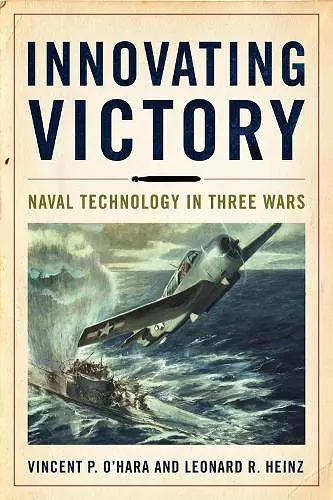Innovating Victory
Naval Technology in Three Wars
Vincent O'Hara author Leonard R Heinz author
Format:Hardback
Publisher:Naval Institute Press
Published:15th Apr '22
Currently unavailable, our supplier has not provided us a restock date

Innovating Victory: Naval Technology in Three Wars, studies how the world's navies incorporated new technologies into their ships, their practices, and their doctrine. It does this by examining six core technologies fundamental to twentieth-century naval warfare including new platforms (submarines and aircraft), new weapons (torpedoes and mines), and new tools (radar and radio). Each chapter considers the state of a subject technology when it was first used in war and what navies expected of it. It then looks at the way navies discovered and developed the technology's best use, in many cases overcoming disappointed expectations. It considers how a new technology threatened its opponents, not to mention its users, and how those threats were managed.
Innovating Victory shows that the use of technology is more than introducing and mastering a new weapon or system. Differences in national resources, force mixtures, priorities, perceptions, and missions forced nations to approach the problems presented by new technologies in different ways. Navies that specialized in specific technologies often held advantages over enemies in some areas but found themselves disadvantaged in others. Vincent P. O'Hara and Leonard Heinz present new perspectives and explore the process of technological introduction and innovation in a way that is relevant to today's navies, which face challenges and questions even greater than those of 1904, 1914, and 1939.
“Innovating Victory is a valuable augmentation of our understanding of how technology influences naval warfare. O’Hara and Heinz chart the influence of six innovative technologies and recount how the combat potential of those technologies was enhanced or constrained by the organizations that developed, refined, and employed them.” —Trent Hone, author of Learning War: The Evolution of Fighting Doctrine in the U.S. Navy, 1898-1945 and co-author of Battle Line: The United States Navy, 1919-1939
“Vincent O'Hara and Leonard Heinz approach an important current problem in a valuable an innovative way: they look at key technological advances and ask how and why the different major navies did or did not benefit. In an age of technological innovation, it is too easy to avoid going beyond the sizzle to ask what should or should not be adopted, and how. The authors' comparative approach is both unusual and extremely valuable.” —Norman Friedman, author of U.S. Submarines Through 1945: An Illustrated Design History
“O'Hara and Heinz are to be congratulated on a fine book about technological innovation. They illustrate the relationship between innovation in the area of military technology (and, secondly, in doctrine) and use of that technology in combat. The work does this by using six weapon case studies: the torpedo, the mine, radio, radar, submarines, and aircraft. The authors argue that assessing innovation ultimately must go through the crucible of combat to assess and develop the technology for the purposes of ‘securing power at sea.’” —Dr. John T. Kuehn, professor of Military History, US Army Command and General Staff College and author of America's First General Staff: A Short History of the Rise and Fall of the General Board of the U.S. Navy, 1900-1950
“This is a marvelous book! O’Hara and Heinz have produced a well-written, well-researched work; full of surprises and a pleasure to read. The exploration of a half dozen key naval innovative technologies covers all major navies; no one nation has a corner on innovation. The trick is translating them into combat capability. The chapters on mines, torpedoes and submarines are particularly germane given heightened anxieties regarding possible conflict with China.” —RADM Michael McDevitt, USN (Ret.), author of China as a Twenty-First-Century Naval Power
“This book is a fascinating history of how new technologies have been made to work in sea warfare. It has as much relevance for contemporary navies as naval historians. Successful innovation as Innovating Victory, depends not just on technical expertise, but imagination, perseverance and a constant focus on the true strategic and operational goals to be achieved.” —Rear Adm. James Goldrick, RAN (Ret.), author of Before Jutland and After Jutland
"Grab this entertaining, enlightening little book. Recommended!" — Cybermodeling Online
"The volume has numerous photographs and charts that enhance the study, as well as an extensive bibliography. Equally weighted chapters provide balance to the book and ensure it is readable to generalists yet informative and thought provoking for all; it is filled with historical examples, well written, and engaging." — Naval War College Review
ISBN: 9781682477328
Dimensions: unknown
Weight: 595g
336 pages